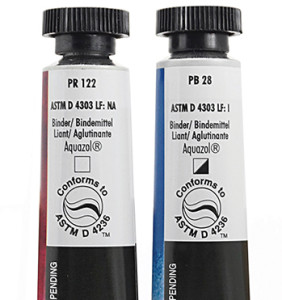Watercolorists are particularly sensitive to issues of lightfastness, and for good reason. Even when framed behind glass, watercolors are still vulnerable to fading because the pigments are very exposed to UV radiation and often used in dilute and delicate washes. Since launching QoR we have received many questions on why some of our colors have a Lighfastness rating of NA, meaning Not Applicable, even while the large majority have an ASTM Lightfastenss of I and just a handful have a II. There have also been questions on why other companies might show a Lightfastness or Permanency rating for an identical pigment that we mark as NA. We wanted to be able to address these concerns directly with you.
The American Society for Testing and Materials (ASTM) creates technical standards that are followed worldwide in all industries and their “Standard Test Methods for Lightfastness of Colorants Used in Artists’ Materials” (D 4303) is by far the most widely accepted and scientifically backed testing procedure currently in place for evaluating how durable a pigment might be. Because of this, we feel strongly that companies should adhere to this standard whenever reporting the lightfastness of their materials.
ASTM Standards for oil, acrylic, and watercolor each maintains a completely separate list of pigments rated for that specific medium. So a pigment listed for oils or acrylics will not necessarily appear on the one for watercolors, and vice versa. Furthermore, the only way to add a color to a list is to put it through all the testing specified by ASTM, including both prolonged outdoor and accelerated indoor exposures. Once completed, those results are submitted to the committee and if approved the color can be included on the list and its ASTM rating placed on a label. From start to finish this process usually takes several years, and sadly no watercolor manufacturer we are aware of has stepped forward to update and expand that list in recent memory. As a result, many pigments with long histories in oils and acrylics are still not included and until that changes, we must list them as unrated when used in watercolors. That is the short term situation. Longer term, we have started a very large project to have all of the colors that we list as NA go through the necessary ASTM testing and be submitted to the committee for approval in early 2016. Once that work is completed we will finally be able to revise our color charts and labels to reflect those official ASTM ratings.

We also want to comment on the use of either a separate “permanency” or lightfastness rating not backed by ASTM. While companies will sometimes use these to supplement or even substitute for an accepted ASTM rating, it is important to realize that only ASTM Standards are peer reviewed by a broad group of manufacturers, scientists, and other consultants and experts in the field, and only approved and published after substantial testing can confirm that the results are reliable and repeatable. Because of that, these private, alternative ratings can mean so many things that without knowing the specific tests that were done, and the exact procedures followed, it is hard to say how accurate they are. As tempting as it is to go that route, we feel that working through the more rigorous ASTM methods is a better solution and provides the assurance that the ratings are backed by a scientifically accepted standard that is available to anyone to read and verify.
We hope this helps explain why some of our QoR paints currently have no lightfastness rating. As always, if you have any concerns or questions about the lightfastness of any of our colors, contact us at 607-847-6154 / 800-959-6543 or email [email protected].
About Sarah Sands
View all posts by Sarah Sands -->Subscribe
Subscribe to the newsletter today!
No related Post

